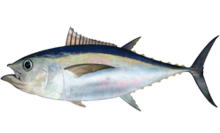| Bigeye tuna | |
|---|---|
 | |
| Conservation status | |
 Vulnerable (IUCN 3.1)[1] | |
| Scientific classification | |
| Kingdom: | Animalia |
| Phylum: | Chordata |
| Class: | Actinopterygii |
| Order: | Perciformes |
| Family: | Scombridae |
| Subfamily: | Scombrinae |
| Tribe: | Thunnini |
| Genus: | Thunnus |
| Subgenus: | Thunnus |
| Species: | T. obesus |
| Binomial name | |
| Thunnus obesus (Lowe, 1839) | |
| Synonyms[2] | |
| |
In Hawaiian, it is one of two species known as ʻahi; the other is yellowfin tuna.[3]
Range and habitat
Bigeye tuna are found in the open waters of all tropical and temperate oceans, but not the Mediterranean Sea.Anatomy
Bigeye tuna vary up to 250 centimetres (98 in) in length. Its maximum weight probably exceeds 400 pounds (180 kg), with the all-tackle angling record standing at 392 pounds (178 kg). They are large, deep-bodied, streamlined fish with large heads and eyes. The pectoral fins are very long, reaching back as far as the second dorsal fin. They display 13 or 14 dorsal spines.Physiology
The bigeye forages in cold and oxygen-poor subsurface waters. Their blood extracts oxygen efficiently even in oxygen-poor conditions. Their vision functions well in low light conditions. The heart has an unusual ability to function effectively while foraging in cold subsurface water. Nonetheless, they must periodically return to warmer surface waters to warm up.Life history
Longer-lived than the closely related yellowfin tuna, the bigeye has a lifespan of up to 12 years, with sexual maturity at age four. Spawning takes place in June and July in the northwestern tropical Atlantic, and in January and February in the Gulf of Guinea, which is the only known Atlantic nursery area.Satellite tagging showed that bigeye tuna often spend prolonged periods diving deep below the surface during the daytime, sometimes reaching 500 metres (1,600 ft). Bigeye have been tracked entering water as cold as 5 °C (41 °F). These movements are thought to be in response to vertical migrations of prey organisms in the deep scattering layer.
Feeding
Feed items include both epipelagic and mesopelagic species, with deep diving behaviour during the day thought to be related to the seeking of prey.Fishery

In 2010, Greenpeace International has added the bigeye tuna to its seafood red list. "The Greenpeace International seafood red list is a list of fish that are commonly sold in supermarkets around the world, and which have a very high risk of being sourced from unsustainable fisheries."[4]
Western and central Pacific
The central and western Pacific provides about 54 percent of the world's tuna, amounting to about 1.3 million tons annually.[5] For the first time ever, NOAA closed the western and central Pacific bigeye fishery to the Hawaii-based longline fishing fleet for the final three days of 2009, having reached the internationally-agreed catch limit of 3,673 metric tons (3,615 long tons). This limit is 30% lower than that of earlier years and will also apply to 2010. The ban does not apply to yellowfin tuna and other fishes or bigeye in the eastern Pacific.[6]The United States and the eight island nations that are part of the so-called Nauru Agreement are negotiating an extension of the 1987 Multilateral Treaty, which allows the United States 40 vessels with no limit on fishing days. That treaty expires on 2013. The island nations want the U.S. to reduce the number of days its boats fish each year and lower quotas by 20-30%. Since 2004, quotas on longline fishing have reduced bigeye fishing by 10 percent.[5]
Hawaii's longline fishing vessels virtually stopped 2010 bigeye fishing in the central and western Pacific as of Nov. 22 after reaching their quota. They continued fishing in nontraditional waters in the eastern Pacific, where trips are longer and tuna may be scarce.[5]
The Western Pacific Regional Fishery Management Council acts as a policy adviser to the U.S. Secretary of Commerce. The council supports a reduction in the use of purse seine nets at fish aggregation devices—open-ocean buoys—because too many juvenile bigeyes are taken before they become sexually mature and can propagate.[5]
At a conference in April, Nauru countries banned purse seine fishing by vessels under license to the group in some high seas around their nations as of January. 1. That agreement covers an estimated 25 percent of the world's tuna catch.[5]
The "Nauru countries" are the Federated States of Micronesia, Kiribati, the Republic of the Marshall Islands, Nauru, the Republic of Palau, Papua New Guinea, Solomon Islands and Tuvalu. Other commission members include Australia, China, Canada, the Cook Islands, the European Union, Fiji, France, Japan, South Korea, New Zealand, Niue, the Philippines, Samoa, Taiwan, Tonga, the United States and Vanuatu.


No comments:
Post a Comment